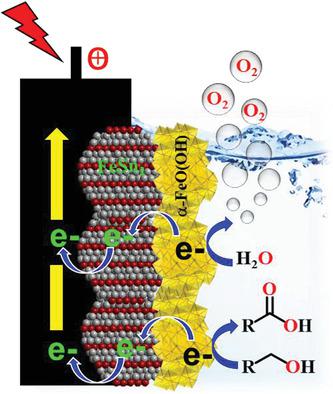当前位置:
X-MOL 学术
›
Adv. Energy Mater.
›
论文详情
Our official English website, www.x-mol.net, welcomes your feedback! (Note: you will need to create a separate account there.)
Enabling Iron‐Based Highly Effective Electrochemical Water‐Splitting and Selective Oxygenation of Organic Substrates through In Situ Surface Modification of Intermetallic Iron Stannide Precatalyst
Advanced Energy Materials ( IF 27.8 ) Pub Date : 2020-06-24 , DOI: 10.1002/aenm.202001377 Biswarup Chakraborty 1 , Rodrigo Beltrán‐Suito 1 , J. Niklas Hausmann 1 , Somenath Garai 2 , Matthias Driess 1 , Prashanth W. Menezes 1
Advanced Energy Materials ( IF 27.8 ) Pub Date : 2020-06-24 , DOI: 10.1002/aenm.202001377 Biswarup Chakraborty 1 , Rodrigo Beltrán‐Suito 1 , J. Niklas Hausmann 1 , Somenath Garai 2 , Matthias Driess 1 , Prashanth W. Menezes 1
Affiliation

|
A strategy to overcome the unsatisfying catalytic performance and the durability of monometallic iron‐based materials for the electrochemical oxygen evolution reaction (OER) is provided by heterobimetallic iron–metal systems. Monometallic Fe catalysts show limited performance mostly due to poor conductivity and stability. Here, by taking advantage of the structurally ordered and highly conducting FeSn2 nanostructure, for the first time, an intermetallic iron material is employed as an efficient anode for the alkaline OER, overall water‐splitting, and also for selective oxygenation of organic substrates. The electrophoretically deposited FeSn2 on nickel foam (NF) and fluorine‐doped tin oxide (FTO) electrodes displays remarkable OER activity and durability with substantially low overpotentials of 197 and 273 mV at 10 mA cm−2, respectively, which outperform most of the benchmarking NiFe‐based catalysts. The resulting superior activity is attributed to the in situ generation of α‐FeO(OH)@FeSn2 where α‐FeO(OH) acts as the active site while FeSn2 remains the conductive core. When the FeSn2 anode is coupled with a Pt cathode for overall alkaline water‐splitting, a reduced cell potential (1.53 V) is attained outperforming that of noble metal‐based catalysts. FeSn2 is further applied as an anode to produce value‐added products through selective oxygenation reactions of organic substrates.
中文翻译:

通过金属间锡化铁预催化剂的原位表面改性,实现铁基质对有机基质的高效电化学水分解和选择性氧化
异双金属铁-金属系统提供了一种策略,用于克服单金属铁基材料对电化学氧释放反应(OER)的不满意的催化性能和耐用性。单金属铁催化剂表现出有限的性能,这主要是由于差的电导率和稳定性。在这里,通过利用结构有序且高导电性的FeSn 2纳米结构,金属间铁材料首次被用作碱性OER,整体水分解以及有机底物选择性氧化的有效阳极。电泳沉积的FeSn 2在泡沫镍(NF)和掺氟氧化锡(FTO)电极上显示出显着的OER活性和耐用性,在10 mA cm -2时的过低电势分别为197和273 mV,显着低,优于大多数基准NiFe基催化剂。产生的优异活性归因于原位生成α-FeO(OH)@FeSn 2,其中α-FeO(OH)充当活性位点,而FeSn 2仍然是导电核。当FeSn 2阳极与Pt阴极耦合以进行整体碱性水分解时,可实现比贵金属催化剂更低的电池电势(1.53 V)。FeSn 2 通过有机底物的选择性氧化反应进一步用作阳极以生产增值产品。
更新日期:2020-08-11
中文翻译:

通过金属间锡化铁预催化剂的原位表面改性,实现铁基质对有机基质的高效电化学水分解和选择性氧化
异双金属铁-金属系统提供了一种策略,用于克服单金属铁基材料对电化学氧释放反应(OER)的不满意的催化性能和耐用性。单金属铁催化剂表现出有限的性能,这主要是由于差的电导率和稳定性。在这里,通过利用结构有序且高导电性的FeSn 2纳米结构,金属间铁材料首次被用作碱性OER,整体水分解以及有机底物选择性氧化的有效阳极。电泳沉积的FeSn 2在泡沫镍(NF)和掺氟氧化锡(FTO)电极上显示出显着的OER活性和耐用性,在10 mA cm -2时的过低电势分别为197和273 mV,显着低,优于大多数基准NiFe基催化剂。产生的优异活性归因于原位生成α-FeO(OH)@FeSn 2,其中α-FeO(OH)充当活性位点,而FeSn 2仍然是导电核。当FeSn 2阳极与Pt阴极耦合以进行整体碱性水分解时,可实现比贵金属催化剂更低的电池电势(1.53 V)。FeSn 2 通过有机底物的选择性氧化反应进一步用作阳极以生产增值产品。


























 京公网安备 11010802027423号
京公网安备 11010802027423号